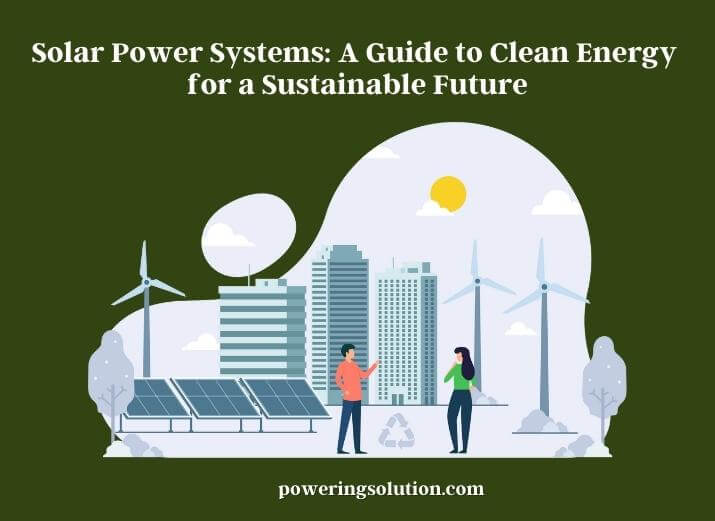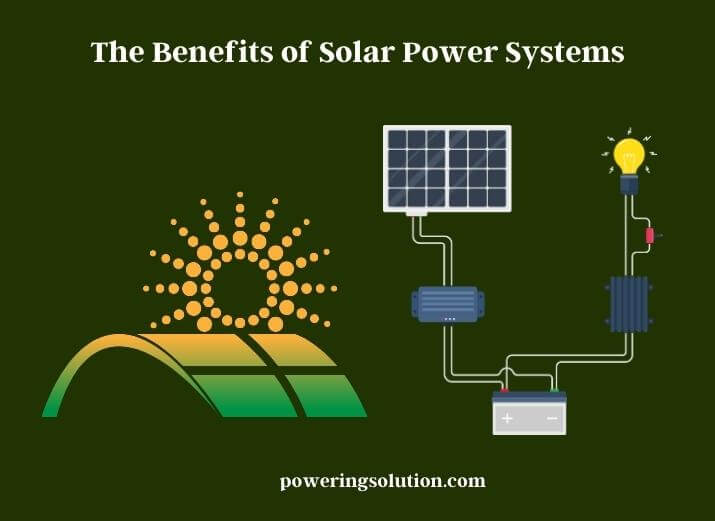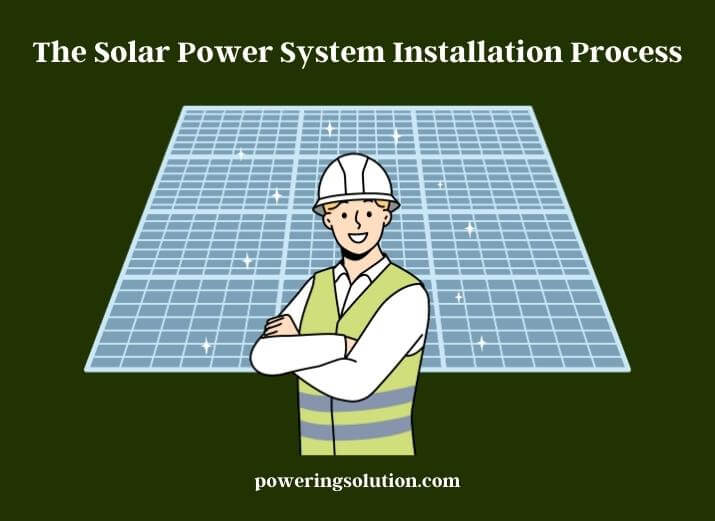Climate change is a global crisis that requires immediate action. One of the most effective ways to combat climate change is by using clean, renewable energy sources like solar power. Solar power systems have become increasingly popular in recent years as the cost of solar panels has decreased and technology has improved.

If you’re considering installing a solar power system in your home or business, this guide is for you. We’ll cover everything you need to know about solar power systems, including the benefits, installation process, and maintenance requirements.
Types of Solar Power Systems
Solar power systems come in a variety of types and sizes, each designed to meet specific energy needs. In this section, we will discuss some of the most common types of solar power systems.
Grid-Tied Systems
A grid-tied solar power system is connected to the utility grid, allowing excess power generated by the system to be sent back to the grid. This excess power is then credited to the owner’s account, resulting in lower energy bills. Grid-tied systems are the most common type of solar power system, and they are ideal for homes or businesses that are already connected to the utility grid.

Off-Grid Systems
Off-grid solar power systems are not connected to the utility grid and are designed to provide power to a remote location or a location without access to the grid. These systems use batteries to store excess power generated during the day, which can be used at night or during periods of low sunlight. Off-grid systems are ideal for remote cabins or homes in rural areas where connection to the grid is not possible.
Hybrid Systems
A hybrid solar power system combines both grid-tied and off-grid systems, providing the benefits of both. These systems are designed to operate on the grid during periods of high demand and to switch to off-grid mode during power outages or periods of low sunlight. Hybrid systems are ideal for areas with unreliable power supplies or for those who want to maximize their energy independence.
Building Integrated Photovoltaic Systems (BIPV)
Building-integrated photovoltaic systems are designed to be integrated into the building structure, such as the roof or walls. These systems are becoming increasingly popular in new construction projects, as they provide a seamless and aesthetically pleasing solution for energy generation.
Concentrated Solar Power Systems
Concentrated solar power systems use mirrors or lenses to concentrate sunlight onto a small area, which heats a fluid that generates steam and drives a turbine to produce electricity. These systems are typically used in large-scale applications, such as utility-scale power plants.
Note
Choosing the right type of solar power system depends on several factors, including energy needs, location, and budget. Whether it’s a grid-tied system, off-grid system, hybrid system, building-integrated photovoltaic system, or concentrated solar power system, solar power is a sustainable and reliable source of energy that can provide significant financial and environmental benefits.
The Benefits of Solar Power Systems
Solar power systems offer numerous benefits, making them a popular choice for homeowners and businesses looking to reduce their carbon footprint and save money on their energy bills. Here are some of the top benefits of solar power systems:

- Reduced Electricity Bills: One of the biggest benefits of solar power systems is that they can significantly reduce your electricity bills. By generating your own energy from the sun, you can offset the amount of electricity you need to purchase from the grid.
- Environmentally Friendly: Solar power is a clean, renewable energy source that does not produce any harmful emissions. By using solar power, you can reduce your carbon footprint and contribute to a more sustainable future.
- Increased Property Value: Installing a solar power system can increase the value of your property. Studies have shown that homes with solar power systems sell for more than those without them, making it a smart investment for homeowners.
- Energy Independence: Solar power systems can provide energy independence and security. By generating your own energy, you can reduce your reliance on the grid and protect yourself from power outages and rising electricity costs.
- Tax Incentives and Rebates: Many governments offer tax incentives and rebates to encourage the adoption of solar power systems. These incentives can offset the initial cost of installation and make solar power more accessible to homeowners and businesses.
Solar power systems offer a wide range of benefits, including reduced electricity bills, environmental sustainability, increased property value, energy independence, and access to tax incentives and rebates. If you’re looking to reduce your carbon footprint and save money on your energy bills, solar power systems are a smart choice.
Understanding How Solar Power Systems Work
Solar power systems work by capturing the energy of the sun and converting it into usable electricity. The process involves several components, including solar panels, inverters, and batteries (optional). Here’s a closer look at how solar power systems work:
- Solar Panels: Solar panels are the main component of a solar power system. They are made up of photovoltaic (PV) cells that capture the energy of the sun and convert it into direct current (DC) electricity.
- Inverters: Inverters are responsible for converting the DC electricity generated by the solar panels into alternating current (AC) electricity, which is the type of electricity used in homes and businesses.
- Batteries (optional): Batteries can be added to a solar power system to store excess energy generated by the solar panels for later use. This allows homeowners and businesses to use solar power even when the sun isn’t shining.
- Net Metering: Net metering is a billing arrangement that allows homeowners and businesses to sell excess solar power back to the grid. When the solar panels generate more electricity than is needed, the excess power is sent back to the grid and credited to the homeowner’s or business’s account.
Choosing the Right Solar Power System for Your Needs
Choosing the right solar power system for your needs requires careful consideration of several factors, including your energy needs, budget, and available space. Here are some things to keep in mind when selecting a solar power system:
- Energy Needs: The first step in choosing a solar power system is to assess your energy needs. This will help you determine the size of the system you’ll need to generate enough electricity to power your home or business. A reputable solar installer can help you calculate your energy needs and recommend a system that will meet them.
- Budget: Solar power systems can vary in price depending on their size and quality. It’s important to set a budget for your solar power system and work with a reputable installer who can help you find a system that fits your budget.
- Available Space: Solar panels require space to be installed, so it’s important to assess your available space before choosing a solar power system. If you have limited space, you may need to opt for a smaller system or consider installing solar panels on your roof.
- Quality: It’s important to choose a high-quality solar power system that will provide reliable and efficient performance for many years to come. Look for a system with high-quality solar panels, inverters, and other components, and choose a reputable installer with a track record of quality work.
- Warranties and Maintenance: Solar power systems typically come with warranties that cover the panels, inverters, and other components. Make sure you understand the terms of the warranty before choosing a system. It’s also important to consider the maintenance requirements of your system and choose a reputable installer who can provide ongoing maintenance and support.
Choosing the right solar power system requires careful consideration of your energy needs, budget, available space, quality, warranties, and maintenance requirements. Working with a reputable installer and carefully assessing these factors, you can choose a solar power system that will meet your needs and provide reliable, sustainable energy for years to come.
The Solar Power System Installation Process
Installing a solar power system can seem like a daunting task, but with the right information and professional help, the process can be relatively straightforward. In this section, we will discuss the typical installation process for solar power systems.

- Site Assessment
The first step in the installation process is to conduct a site assessment. This involves a professional solar installer visiting the site to evaluate the location’s solar potential, shading, and orientation. The installer will also evaluate the electrical and structural characteristics of the building to determine if any upgrades or modifications are necessary.
- Design and Permitting
Once the site assessment is complete, the installer will design a custom solar power system that meets the client’s energy needs and site characteristics. This includes determining the size and number of solar panels, inverter type, and battery storage requirements. The installer will also obtain any necessary permits and approvals from the local government and utility company.
- Installation
Once the design and permitting process is complete, the installer will begin the installation process. This typically involves mounting the solar panels on the roof or a ground-mounted rack and installing the inverter and battery storage system. The installer will also connect the system to the electrical grid and perform any necessary electrical work.
- Inspection and Commissioning
After the installation is complete, the installer will perform a final inspection to ensure that the system is operating correctly and safely. This includes verifying that all electrical connections are secure and up to code. Once the inspection is complete, the system will be commissioned, which involves turning on the system and ensuring that it is producing the expected amount of energy.
- Monitoring and Maintenance
Once the solar power system is up and running, it is important to monitor its performance and conduct regular maintenance to ensure its longevity and efficiency. This includes monitoring energy production and consumption, inspecting the system for damage or wear, and cleaning the solar panels to ensure maximum energy production.
Maintaining Your Solar Power System
Once you have installed a solar power system, it is important to ensure that it is well-maintained to ensure it functions efficiently and effectively. Proper maintenance of your solar power system can help maximize its lifespan, prevent unnecessary repairs, and ensure that it continues to produce clean energy for your home or business. In this section, we will discuss some tips for maintaining your solar power system.
Regular Cleaning
One of the most important things you can do to maintain your solar power system is to keep it clean. Dirt, debris, and dust can accumulate on the solar panels, which can reduce their efficiency and effectiveness. To prevent this, it is recommended to clean your solar panels at least twice a year or as needed. You can use a soft cloth or a gentle brush to remove any dirt or debris from the panels.
Monitoring Performance
Another way to maintain your solar power system is to monitor its performance regularly. You can do this by checking the system’s output on a regular basis. This will allow you to identify any changes in output, which can indicate a problem with the system. If you notice a significant decrease in output, it may be time to call in a professional to inspect the system.
Battery Maintenance
If your solar power system includes batteries, it is important to maintain them properly to ensure that they function correctly. This can include checking the battery water levels, cleaning the battery terminals, and testing the battery’s charge. You should also ensure that the batteries are kept in a cool, dry location to prevent damage from overheating or moisture.
Inspecting Components
Regularly inspecting the various components of your solar power system can also help to maintain its efficiency. This can include checking the wiring, fuses, and connectors for any signs of damage or wear. You should also inspect the solar panels themselves for any cracks or damage, as this can affect their ability to produce energy.
Professional Maintenance
It is important to schedule regular professional maintenance for your solar power system. This can include inspections, cleanings, and repairs as needed. A professional can identify any potential problems with the system and provide recommendations for maintenance or repairs.
Last Point
Solar power systems have emerged as a promising solution for meeting our growing energy demands in a sustainable manner. They offer numerous benefits, including reduced carbon emissions, increased energy independence, and financial savings.
It is important to keep in mind that every solar power system is unique, and it is essential to consult with a professional to determine the best solution for your needs. With the advancements in technology and increasing awareness of environmental concerns, solar power systems are becoming more accessible and affordable. Therefore, investing in a solar power system is not only a responsible decision for the environment but also a smart financial investment.
